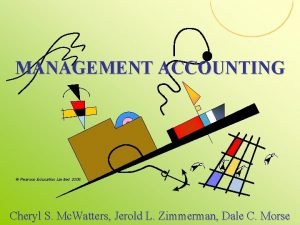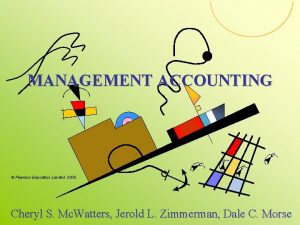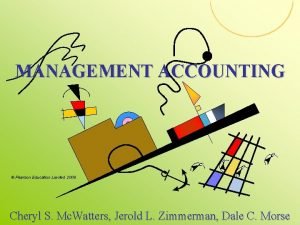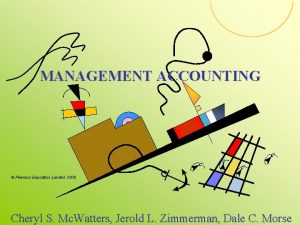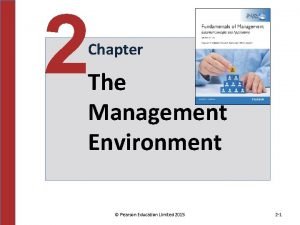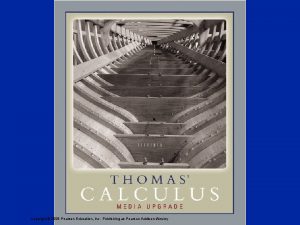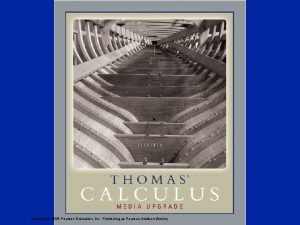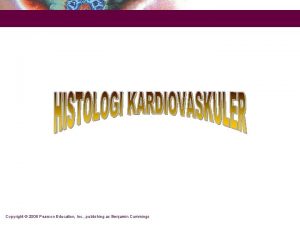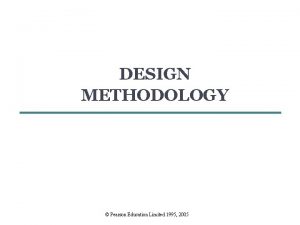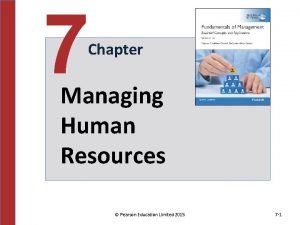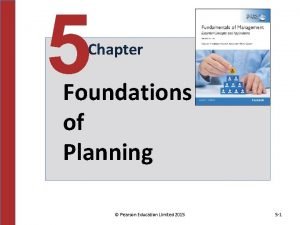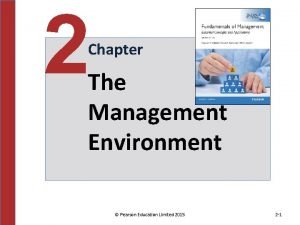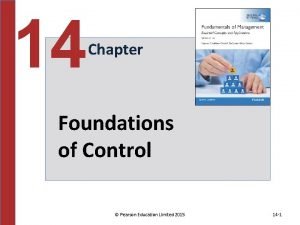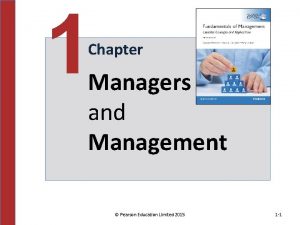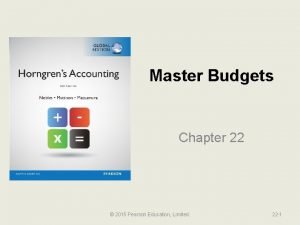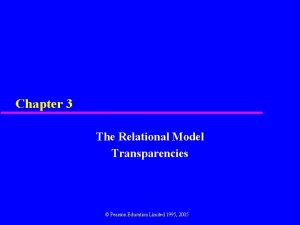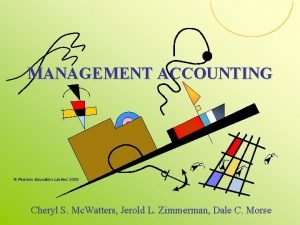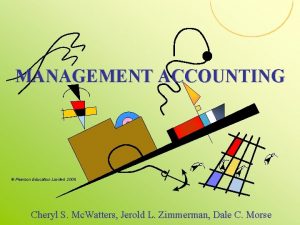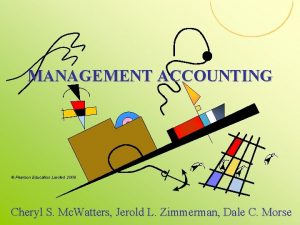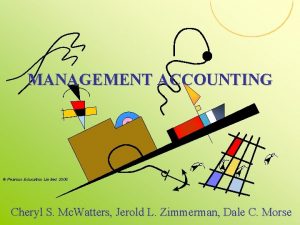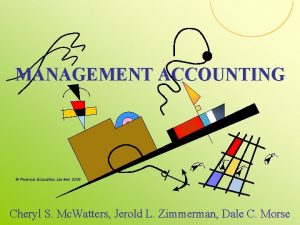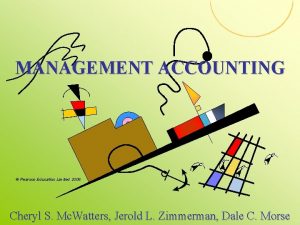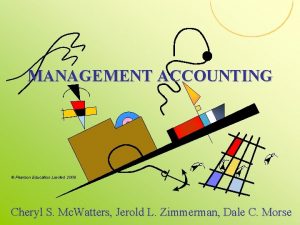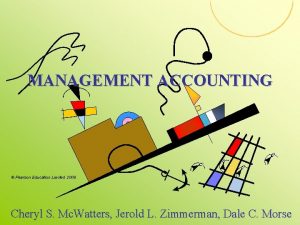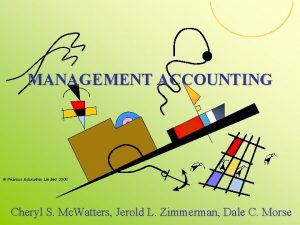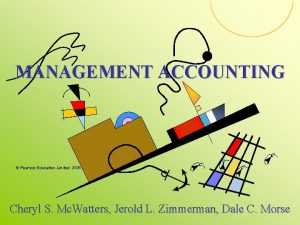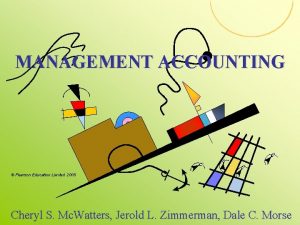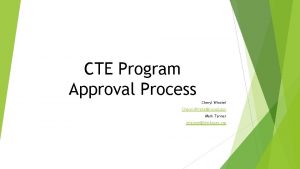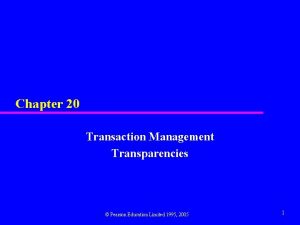MANAGEMENT ACCOUNTING Pearson Education Limited 2008 Cheryl S



























- Slides: 27

MANAGEMENT ACCOUNTING © Pearson Education Limited 2008 Cheryl S. Mc. Watters, Jerold L. Zimmerman, Dale C. Morse

4 -2 Managing activities (Strategy and planning) Chapter 4 Management Accounting Mc. Watters, Zimmerman, Morse © Pearson Education Limited 2008

4 -3 Objectives • Select a competitive strategy for an organization • Use activity-based management to reduce the costs of an organization without affecting customer value • Make trade-offs in the product life cycle to reduce overall product costs • Use target costing as a method to select viable products and reduce product cost • Estimate the costs of using different suppliers • Use supply chain management to operate more efficiently and reduce costs • Estimate customer profitability • Make pricing decisions that maximize organizational value • Explain why some organizations use cost-based pricing Management Accounting Mc. Watters, Zimmerman, Morse © Pearson Education Limited 2008

4 -4 Strategic Decisions OR To compete through innovative product and service design Must excel at understanding customers Strategic Decision To compete through lowcost production Must excel through efficient production OR Management Accounting Mc. Watters, Zimmerman, Morse OR To compete through the delivery of highquality products? Must excel in manufacturing and delivery of customer service © Pearson Education Limited 2008

4 -5 Strategic Decisions Have long-term implications Go beyond the confines of the organization Normally made by leaders of the organization Strategic Decisions Consider how the organization can take advantage of opportunities Consider the strengths and weaknesses of the organization Provide focus and direction Management Accounting Mc. Watters, Zimmerman, Morse © Pearson Education Limited 2008

4 -6 Activity-Based Management and the Value Chain Activity-based costing (ABC) provides an alternative way of tracing costs to products that, in some cases, leads to very different production costs Activity-based management (ABM) extends ABC by analyzing the management of activities, instead of simply retracing the costs of activities. The goal is to provide value to the customer and profit to the shareholders Management Accounting Mc. Watters, Zimmerman, Morse © Pearson Education Limited 2008

Activity-Based Management and the Value Chain Delivering ABM achieves the twin goals of achieving customer and shareholder value primarily through the analysis of activities along the value chain Shooting Designing the film sets and costumes Value Chain for a motion picture The actors Writing Script Management Accounting Mc. Watters, Zimmerman, Morse 4 -7 the film to theatres Advertising Editing Activities that add value to the customer are called value added activities © Pearson Education Limited 2008

4 -8 Activity-Based Management and the Value Chain An organization should consider the “best practices” of other organizations to establish a benchmarks for evaluating its own practices An organization should consider whether to “outsource” an activity Management Accounting Mc. Watters, Zimmerman, Morse © Pearson Education Limited 2008

4 -9 Cost Reduction ABM is one approach to reducing costs. The identification and reduction of non-valueadded activities can increase profits by lowering costs Product Life Cycle costing is another approach to reducing costs Another approach to reducing costs is Target Costing Management Accounting Mc. Watters, Zimmerman, Morse © Pearson Education Limited 2008

4 -10 Cost Reduction Numerical Example An Internet retailer purchases furnishings from different manufacturers and ships them to the company headquarters from where it distributes the products in its own vehicle fleet Activity Cost (£) Cost of best competitor Purchasing 5, 000 6, 000 Shipping to Liverpool 3, 000 2, 000 Receiving 500, 000 600, 000 Warehousing 2, 000, 000 Web page maintenance 800, 000 600, 000 Order processing 4, 000 4, 500, 000 Shipping to customer 3, 000 2, 000 Management Accounting Mc. Watters, Zimmerman, Morse Three activities are not on the value chain. Those activities could be replaced by shipping directly to the customer © Pearson Education Limited 2008

4 -11 Product Life Cycle Start Customer Service Production Design Product life cycle describes the stages of supplying a product or service from its initial conception to the satisfaction of the last customer Marketing Engineering Management Accounting Mc. Watters, Zimmerman, Morse © Pearson Education Limited 2008

4 -12 Product Life Cycle and Costs Stage 2000 2001 2002 2003 2004 Totals £ £ £ Costs later stages are Design of the 100, 000 50, 000 Marketing 20, 000 40, 000 100, 000 heavily influenced by the Engineering 80, 000 10, 000 Production 100, 000 decisions made during the 800, 000 Customer Service 30, 000 earlier stages Total Product Cost Percentage of Life Cycle Costs 100% 150, 000 30, 000 10, 000 200, 000 700, 000 1, 700, 000 40, 000 50, 000 120, 000 10, 000 2, 370, 000 Committed Costs 50% Incurred Costs 0% Planning Design & Engineering Management Accounting Mc. Watters, Zimmerman, Morse Production Customer Service © Pearson Education Limited 2008

4 -13 Target Costing is a strategic management process of reducing costs at the early stages of product planning and design Target Cost = Target Selling Price – Target Profit Management Accounting Mc. Watters, Zimmerman, Morse © Pearson Education Limited 2008

4 -14 Target Costing Identify product opportunity Determine price that would make product competitive Determine if product can be made at cost sufficiently low to provide a profit Management Accounting Mc. Watters, Zimmerman, Morse © Pearson Education Limited 2008

4 -15 Supply Chain Management and Costs Supply chain management focuses on relations with other organizations. Products and services flow into the organization from external suppliers and products and services flow out to customers Management Accounting Mc. Watters, Zimmerman, Morse © Pearson Education Limited 2008

4 -16 Estimating the Cost of a Supplier Cost of purchasing Timeliness of delivery Treating the Supplier as a cost The will Costidentify of a object Supplier whether the supplier is a low-cost option Packaging of parts or products Management Accounting Mc. Watters, Zimmerman, Morse Quality of supplier’s products © Pearson Education Limited 2008

4 -17 Working with Suppliers to Reduce Costs Use business-to. Reduce warehouse business ecommerce costs by close communication Ways in which suppliers can reduce customers’ costs Enter into long -term relations Implement JIT systems Link computer systems by electronic data interchange (EDI) Management Accounting Mc. Watters, Zimmerman, Morse © Pearson Education Limited 2008

4 -18 Customer Relations and Profitability Customer-related costs are compared with the benefits of having the customer. In some cases, the cost of having a customer is higher than the benefit received Management Accounting Mc. Watters, Zimmerman, Morse © Pearson Education Limited 2008

4 -19 Customer Relations and Profitability Numerical Example James Wilson purchases 1, 000 windows annually from Clear Windows for £ 120, 000. The product cost is £ 80 per window (not including transportation and customer service costs). It costs Clear Windows £ 10, 000 to deliver the windows. Employees at Clear Windows spend 80 hours a year on customer service (cost £ 20 per hr) Cost of goods sold £ 80, 000 Cost of transportation £ 10, 000 Cost of service £ 1, 600 Total cost £ 91, 600 What is the annual net benefit to Clear Windows of having Annual net benefit £ 120, 000 – £ 91, 600 = £ 28, 400 James Wilson as a customer? Management Accounting Mc. Watters, Zimmerman, Morse © Pearson Education Limited 2008

4 -20 Pricing to and Customer Value An important strategic planning decision is the pricing of products and services The pricing decision is complicated and requires knowledge of Customers Management Accounting Mc. Watters, Zimmerman, Morse Competitors (present and potential) Product costs © Pearson Education Limited 2008

4 -21 Pricing to Maximize Organizational Value –Numerical Example A schedule of quantities and prices for kayaks showing changing demand with changing prices Kayaks sold Price per unit (£) Total Revenue (£) 100 90, 000 150 800 120, 000 200 700 140, 000 300 600 180, 000 400 500 200, 000 480 400 192, 000 600 300 180, 000 Management Accounting Mc. Watters, Zimmerman, Morse As the price drops, the units sold increase © Pearson Education Limited 2008

4 -22 Pricing to Maximize Organizational Value –Numerical Example In Fixed order costs to maximize are £ 50, 000 added andvalue variable 300 costs kayaks areshould £ 300 be produced at a selling per kayak price of £ 600 per unit Kayaks sold Price (£) Total revenue (£) Total cost (£) Added Value 100 90, 000 80, 000 150 800 120, 000 95, 000 200 700 140, 000 110, 000 300 600 180, 000 140, 000 400 500 200, 000 170, 000 30, 000 480 400 192, 000 194, 000 -2, 000 600 300 180, 000 230, 000 -50, 000 Management Accounting Mc. Watters, Zimmerman, Morse © Pearson Education Limited 2008

4 -23 Pricing in a Competitive Environment Organizations that choose to compete by offering innovative products and services have a more difficult pricing decision because there is no existing price for the new product or service Once competition enters the market, the price of a product becomes squeezed between the cost of the product and the lowest price of a competitor Organizations that produce at a high cost must consider removing that product from their mix Management Accounting Mc. Watters, Zimmerman, Morse © Pearson Education Limited 2008

4 -24 Cost-Based Pricing A recent study reported that firms viewed cost information as an important factor in pricing decisions Cost-based pricing generally uses the average product costs as the base A percentage is added to the average product cost to cover period costs and provide a profit Management Accounting Mc. Watters, Zimmerman, Morse © Pearson Education Limited 2008

4 -25 Cost-Based Pricing Difficulty in estimating customer value and, therefore, demand at different prices Contracts and regulations Long-run customer goodwill Reasons given for pricing based only on product costs Discouraging competition Management Accounting Mc. Watters, Zimmerman, Morse © Pearson Education Limited 2008

4 -26 Cost-Based Pricing a product below its cost reduces the value of the organization Two Exceptions Lead-loss pricing. Selling a particular product at a price below cost to lure customers Management Accounting Mc. Watters, Zimmerman, Morse Predatory pricing. Selling a particular product at a price below cost to drive out competition © Pearson Education Limited 2008

4 -27 MANAGEMENT ACCOUNTING Managing activities (Strategy and planning) End of Chapter 4 Management Accounting Mc. Watters, Zimmerman, Morse © Pearson Education Limited 2008
 Pearson education limited 2008
Pearson education limited 2008 Pearson education limited 2008
Pearson education limited 2008 Pearson education limited 2008
Pearson education limited 2008 Master budget format
Master budget format Pearson education limited 2015
Pearson education limited 2015 2008 pearson education inc
2008 pearson education inc 2008 pearson education inc
2008 pearson education inc 2008 pearson education inc
2008 pearson education inc 2008 pearson education inc
2008 pearson education inc 2008 pearson education inc
2008 pearson education inc Pearson
Pearson 2008 pearson education inc
2008 pearson education inc Pearson education publishing as benjamin cummings
Pearson education publishing as benjamin cummings Pearson education limited 2005
Pearson education limited 2005 Pearson education
Pearson education Pearson education limited 2017
Pearson education limited 2017 Pearson education limited 2015
Pearson education limited 2015 Foundations of planning
Foundations of planning Pearson education limited 2015
Pearson education limited 2015 Pearson education limited 2015
Pearson education limited 2015 Pearson education limited 2015
Pearson education limited 2015 Pearson education limited 2015
Pearson education limited 2015 Pearson education limited 2015
Pearson education limited 2015 Pearson education limited 2015
Pearson education limited 2015 Pearson education limited 2005
Pearson education limited 2005 Pearson education inc publishing as pearson prentice hall
Pearson education inc publishing as pearson prentice hall Pearson education 2011
Pearson education 2011 Pearson education inc publishing as pearson prentice hall
Pearson education inc publishing as pearson prentice hall
